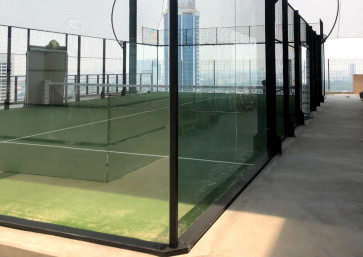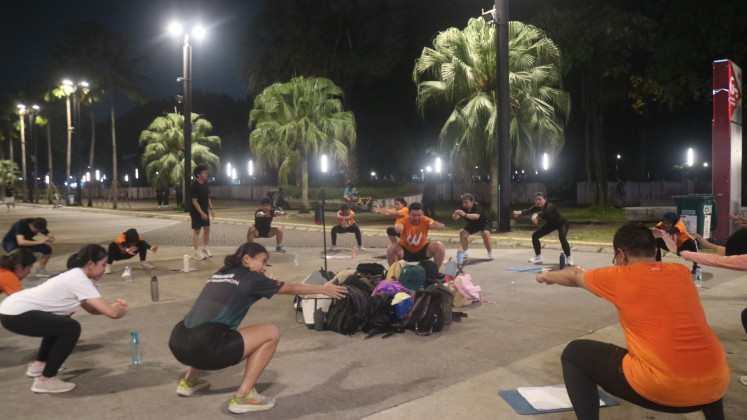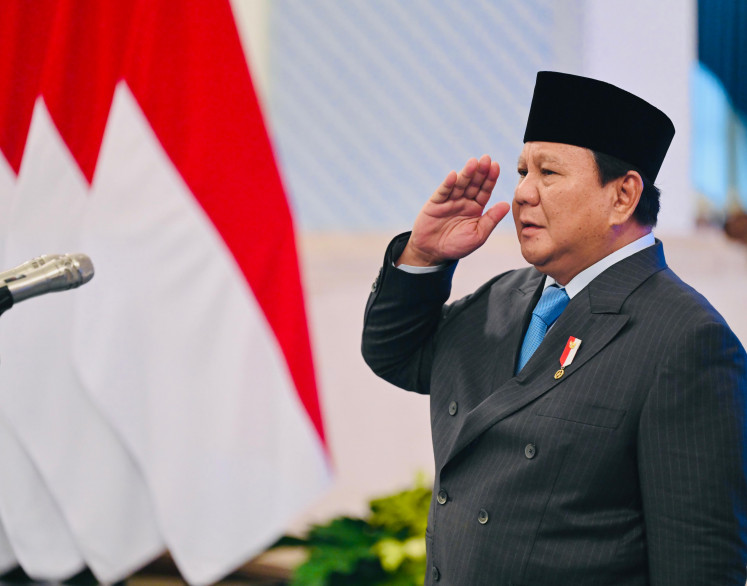Popular Reads
Top Results
Can't find what you're looking for?
View all search resultsPopular Reads
Top Results
Can't find what you're looking for?
View all search resultsCapturing batik’s stories
Heritage: Agusis stands between his pieces titled Solo Batik Carnival and Pak Juragan Batik
Change text size
Gift Premium Articles
to Anyone
Heritage: Agusis stands between his pieces titled Solo Batik Carnival and Pak Juragan Batik. (JP/ Purba Wirastama)
Agus Siswanto, a painter from Surakarta, makes batik.
But he doesn’t make it on cloth as other artisans usually do. Instead, he puts batik on canvas, along with depicting the people and activities as well.
The works are his newest, showing in a solo exhibition titled “Batik mendunia” (Batik Goes Global) at Jakarta’s Tembi Rumah Budaya starting Nov. 7.
About 50 visitors attended the Tembi opening, battling rain and traffic in Kebayoran Baru. They stood inside the exhibition room, paintings covering the walls surrounding them. And in a simple ceremony, the exhibition was opened at 8 p.m.
Agusis, as he usually called, in a leaf-patterned blue shirt, gave the welcoming speech. Then Masrokhan, Jakarta’s assistant deputy governor for Tourism, gave a short speech. Masrokhan was there in place of Governor Joko “Jokowi” Widodo who could not attend.
After officially opening the exhibition, Masrokhan asked Agusis to walk around and tell some stories about his works.
Tiga Wanita Pembatik. (Courtesy of Tembi)Agusis was born on Aug. 26, 1972, and studied in the woodworking department of Indonesian Arts College (STSI) now Indonesian Art Institute (ISI) in Surakarta, graduating in 1997. He started painting on high school, and since 1994 has been part of 50 group exhibitions, as well as solo exhibitions in Jakarta and Solo. He has also established the painting studio Raih Prestasi (Get Achievement) for children in his village of Punggawan in Solo. Local children can participate events at the studio for free.
For his current exhibition, Agusis took batik as the theme in his mission to introduce batik as a painting medium to the world. Especially since UNESCO officially proclaimed Indonesian batik an intangible cultural heritage of humanity.
Ngolorot Malam. (Courtesy of Tembi)There are 22 pieces of art on view, filling the walls of two parts of the exhibition hall. All the works are acrylic on canvas and vary in size from 98 to 200 centimeters long.
Agusis captured in his works slices of life related to batik, including its production, distribution and the use of batik cloth. He especially wanted to show activities related to batik making.
As an example, in a piece titled Tiga Wanita Pembatik (Three Batik-making Women), three women are shown making Sekar Rinonce, Ngreni and Parang patterns with canting (a tool for batik-making) on cloth.
“I visualized [them], so people know that mbatik [batik making] is nyanthing (making patterns with a canting) first, then coloring. If only words, we would not understand because [the terms] are Javanese. Not many people know about nglorot. Evidently, it is [soaking cloth into] boiled water in order to remove the wax,” Agusis said while pointing at a piece titled Nglorot Malam.
People, according to Agusis, don’t always know much about the batik making process and how
difficult the steps are.
“There is pattern making, nglorot, coloring, wind-exposing and then washing. These [steps] are more difficult than common cloth,” he said.
On opening night, some visitors approached Agusis to ask about any patterns or pieces. Others invited him to chat and discuss.
“It’s good. We introduce people to our own culture,” Mawar, in attendance with friends from Kemang’s Koi Gallery, said.
Batik cloth was always painted in detail in Agusis’ works. And besides painting humans, Agusis did “batik making” on his canvases as well. According to him, almost all the batik patterns he painted are rare. And, all of them are from Solo.
“There is Angkasana, there is Gading Warna. We had not heard [of them] before, hadn’t we? Almost all batik cloth we use have Gawung or Parang patterns,” he said.
In fact, there are a lot of batik patterns. Agusis said he painted only patterns he knew, like Sidomukti, Ngreni, Bondet, Truntum and Mega Mendung.
Visitors can see the works at Jakarta’s Tembi Rumah Budaya till Nov. 21.
Agusis also plans to develop his works with other Solo batik patterns and perhaps other regions of Indonesia.
Batik Mendunia
Tembi Rumah Budaya
48 B Jl. Gandaria I
Kebayoran Baru
South Jakarta
+62 21 720 3055
Until Nov. 21












